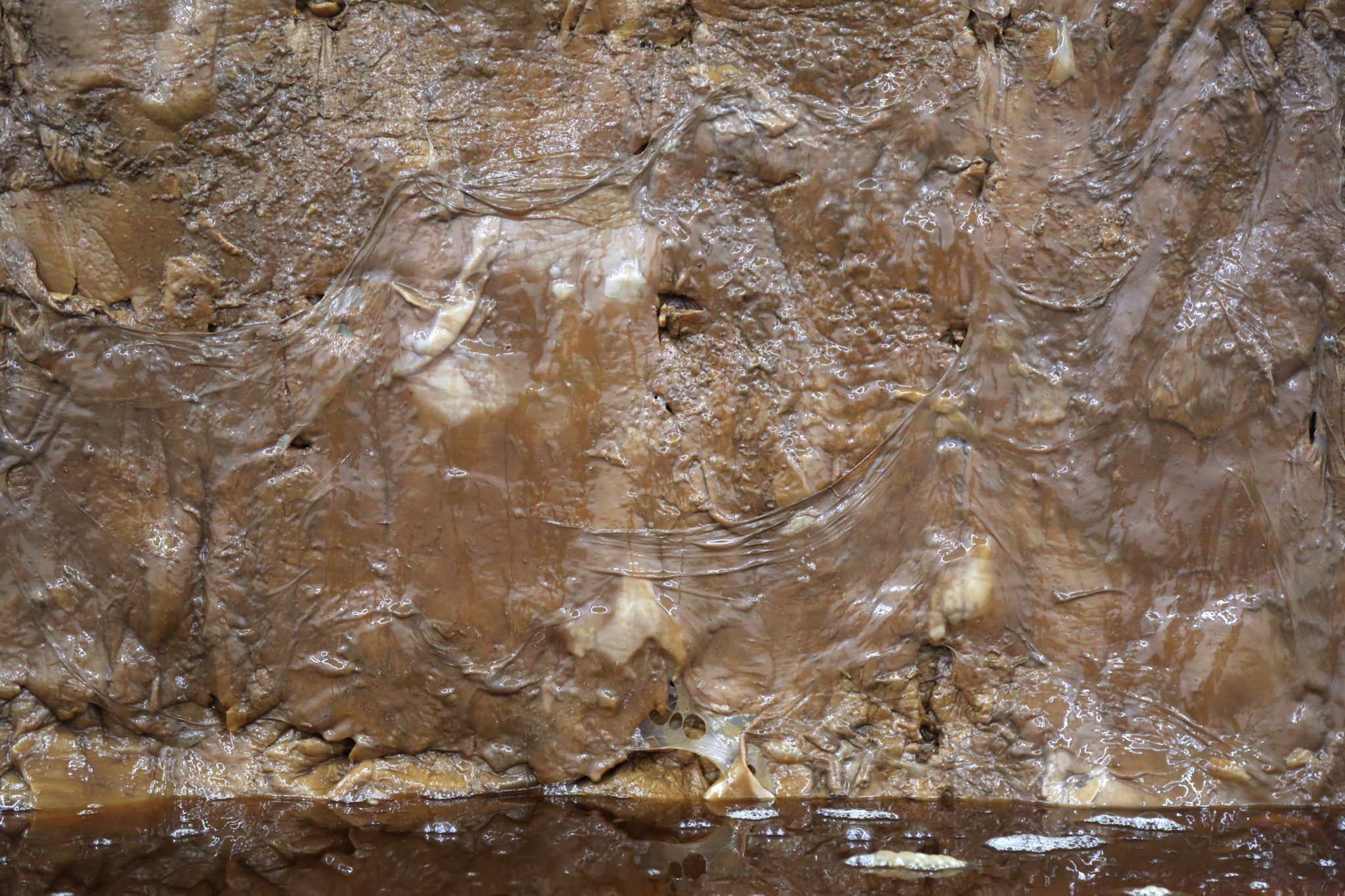No. 39
Cleaning Up After a Catastrophe – Towards an Affinity Institution
15.05.2024
Zofia nierodzińska
‘Organising holds the world together’[1], write Lara Perry and Elke Krasny in the introduction to the book they edited, Curating as Feminist Organising. Referring to reproductive work and everyday chores, they define curating as an activity focused on maintaining relationships, based on communication and repairing, and distanced from the ambition to create something original. ‘Without organising, our world . . . would simply fall apart’[2], they continue, distinguishing between state-level organising and grassroots efforts that take place beyond established structures. Feminist curating, they argue, is a material, pragmatic, decidedly political action that dismantles official power hierarchies and, more importantly, proposes viable alternatives.
When Aleksandra Skowrońska, the curator of the exhibition Does the Rising Sun Affright[3], one of two exhibitions[4] that opened on the same day shortly after Janusz Janowski’s dismissal as director of Zachęta, asked me to write this text, I began to think about how Timothy Morton’s concepts, which Skowrońska refers to in her work, correspond to the feminist curatorial methodology described above.
[1] Curating as Feminist Organizing, ed. Elke Krasny and Lara Perry, London–New York: Routledge, 2023, p. 1.
[2] Ibid., p. 1.
[3] Zob. https://zacheta.art.pl/en/wystawy/zza-gor-sie-slonce-wznosi-blade?setlang=1 (accessed 9 April 2024).
[4] The second is called From the Ashes, curator: Michalina Sablik.
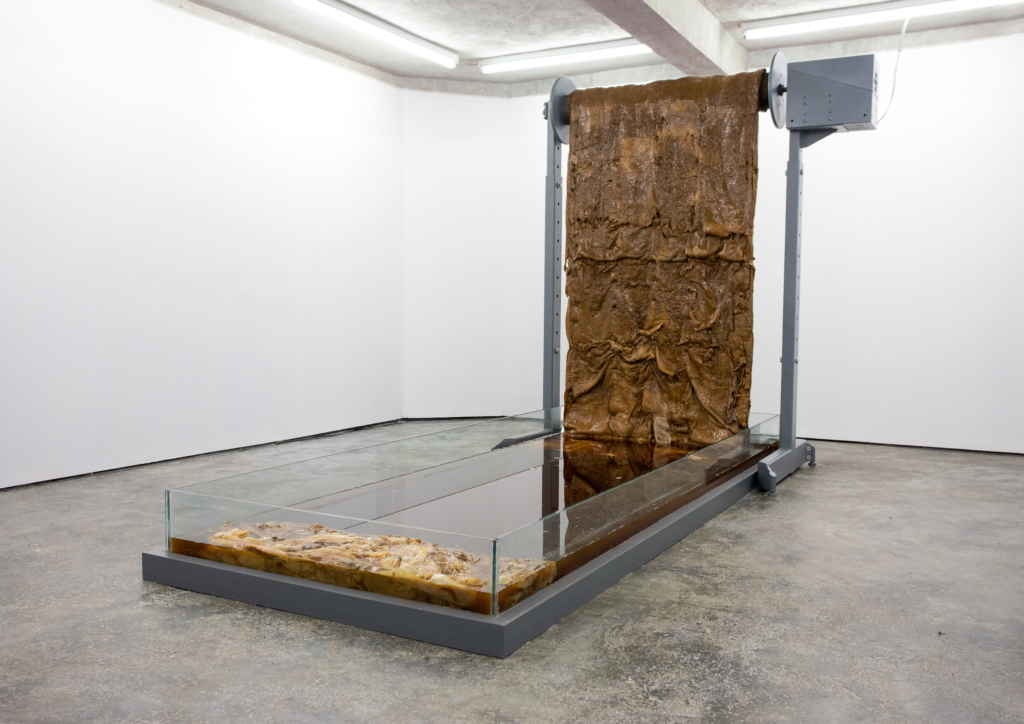
Dark Ecology and the Hyperobject
I will first examine two concepts from Morton’s lexicon that permeate the exhibition at Zachęta. The British theoretician’s thought[5], which I have come to know in the Polish context largely through the popularising work of Andrzej Marzec[6], is the opposite of the Romantic concept of nature, which exists separately from the world of human civilisation and symbolises harmony and primordial beauty. In place of this concept, Morton prefers the term ‘dark ecology’, which aims to evoke a justified sense of unease. It is associated with a melancholic ethics, an inseparable element of life on a destroyed planet, in the very midst of an ongoing climate catastrophe. Morton calls for accepting the material world as it is in the era of late capitalism: polluted, exploited, contaminated with mercury and plastic. The philosopher refers to the problems of this world, such as global warming or the decline of biodiversity, as hyperobjects; ‘hyper’, because they cannot be grasped by the mind, by sight or by touch; ‘objects’, because as a philosopher he continues theoretical exploration in the field of object-oriented ontology[7]. Like other representatives of this school (Graham Harman, Levi Bryant), Morton rejects the exceptional position of the human being characteristic of anthropocentric thinking and recognises agency of objects. Hyperobjects, such as the machinery of capitalism or a plastic bag that decomposes over hundreds of years, are at once invisible and palpable, ubiquitous and distant, characterised by repetition and viscosity (they are inescapable, they are global and microscopic, their traces can even be found in the digestive tract), more complex than anything yet faced by humanity, which itself is an inextricable part of this blown-up reality. Hyperobjects evoke fascination and horror. In the exhibition in Zachęta, they were expressed in a surprisingly aesthetic way, which reminded me Susan Schuppli’s concept of ‘extreme aesthetic products’[8], i.e. images of ecological disasters which, like petrol slicks in water, are extremely attractive phenomena despite the dangers they pose. It seems that both the curator and the invited artists primarily sought to convey a certain intuition, which Morton calls ‘attunement’[9], characteristic of the awareness of being ‘glued’ to the overwhelming, post-anthropocentric, uncontrollable reality.
Skowrońska’s exhibition evokes Morton’s concept of the ‘mesh’ of all creatures and things, which I in my opinion is best conveyed by Bianka Hlywa’s video Thermaloop[10] (2022), which evokes sensations on the border between abjection and fascination. All the works presented in the exhibition are formally and conceptually entangled, which makes the exhibition very coherent and thus responds to Morton’s call for art to be the most adequate means of communication in the age of hyperobjects, more effective than language.
Unlike the art critic Piotr Policht[11], while experiencing the exhibition, I don’t see the quest for visions of the future characteristic for the 20th century avant-garde. Instead, I feel a sense of helplessness and immersion in an inescapable, swampy present. Perhaps this is because the omnipresence of hyperobjects is overwhelming. They evoke a sense of awe, reminding us of the much older and more domesticated concept of god. The problem with this parallel is that pantheistic philosophies leave little margin for agency. The magnitude of the hyperobject stifles and terrifies; it is hard to imagine any action in the face of this all-pervading, non-human entity. Adopting such an attitude risks relinquishing agency and delegating it to a god-like hyperobject that takes us back to the Middle Ages, before emancipation, or/and brings us closer to the realm of esoterics.[12]
[5] See eg, Timothy Morton, Dark Ecology: for a logic of future coexistence, New York: Columbia University Press, 2016.
[6] Andrzej Marzec, ‘„Jesteśmy połączonym ze sobą światem”– Timothy Morton i widmo innej wspólnoty’, Teksty Drugie, no. 2, 2018, pp. 88–101.
[7] See, eg https://www.artspace.com/magazine/interviews_features/the_big_idea/a-guide-to-object-oriented-ontology-art-53690 (accessed 9 April 2024).
[8] See https://susanschuppli.com/EARTH-EVIDENCE (accessed 9 April 2024).
[9] See https://ecologywithoutnature.blogspot.com/2014/11/attunement.html (accessed 9 April 2024).
[10] See https://flash—art.com/2022/10/bianca-hlywa/ (accessed 9 April 2024).
[11] See https://magazynszum.pl/mysl-z-przyszlosci-i-inne-mity-wokol-nowych-wystaw-w-zachecie-i-warszawy-w-budowie-15/ (accessed 9 April 2024).
[12] Obviously, Timothy Morton’s philosophy is much more complex. Here I am referring to the feeling evoked by the concept of the hyperobject, rather than arguing against the British philosopher’s entire body of thought.
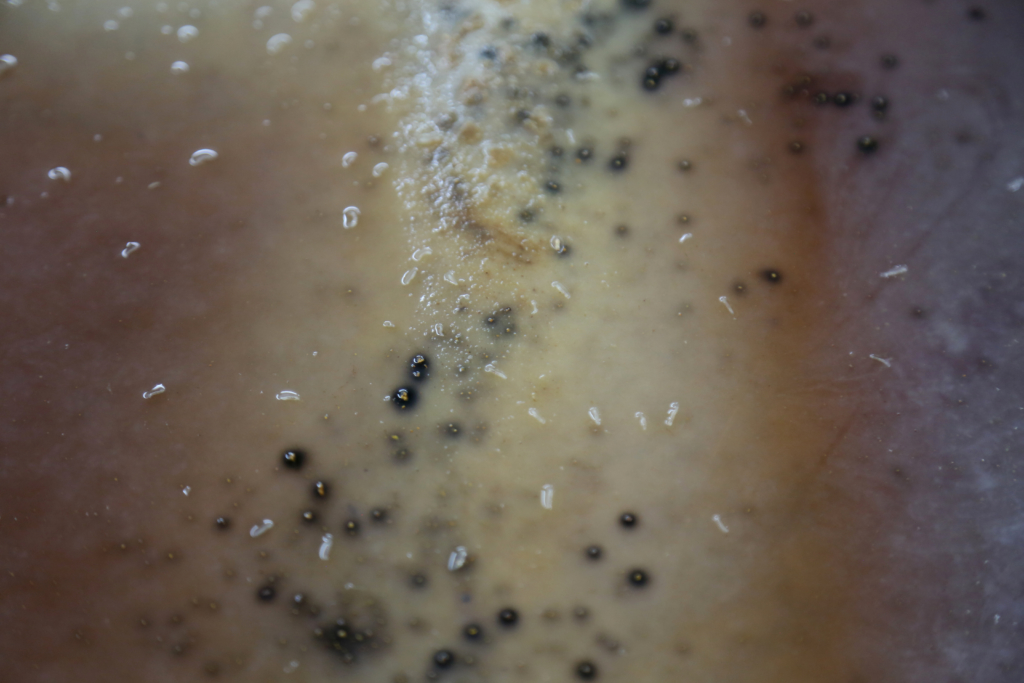
Harvesting as a Counter-catastrophic Activity
Therefore, in order to maintain a feminist balance, I return to thinking about ordinary activities related to cleaning, harvesting and repairing. I recall the classic interventions of Mierle Laderman Ukeles under the banner of ‘Maintenance Art’[13], which is oriented towards providing services rather than creating objects – ‘maintenance’ in the sense of sustaining, preserving and upholding.
As a woman, artist and mother, Laderman Ukeles devoted much of her time to the reproductive labour involved in maintaining the home and keeping herself and her family alive. During the 1979–1980 oil crisis in the United States, the artist decided to become an unsalaried artist-in-residence for the New York City Department of Sanitation. During her residency, she carried out Touch Sanitation Performance, in which she shook hands with 8,500 sanitation workers and told them, ‘Thank you for keeping New York alive’.[14] Her action was intended to show that the system is made up of real people who are reduced to invisibility by the logic of the symbolic realm that degrades maintenance work. Unlike most politicians, the artist did not limit herself to a photo-op, but spent whole days with different groups of workers, showing that as a mother engaged in unpaid reproductive labour, she identified with the whole, often undervalued, sphere of maintenance. In her 1969 Maintenance Art Manifesto (Maintenance Art Manifesto 1969! Proposal for an Exhibition ‘CARE’) [15], she proposed a broad coalition of maintenance and service workers: ‘I felt as if I could never regain my agency until all those involved in maintenance in the general, urban dimension also regained theirs’[16].
In the Polish context, similar work is being done by Marta Romankiv, calling for the rights of domestic workers and valuing care services. This is the case with her proposal for a monument of a maid, Allegory of Domestic Work (prototype) (2023). Romankiv designed the prototype after holding workshops with people engaged in paid domestic work. The sculpture aims to fill gaps in representation and collective history that often overlooks the effort of reproductive labour. The piece is accompanied by a printing plate with a quote from Memoirs of a Poor Maid’s Youth, in which Marie Sansgêne describes the experience of being a maid in Gdańsk in the late 19th century and the story of her own emancipation: ‘I find it most difficult to endure the contempt of others and the abuse of my rights, and so I try with all my might to defend myself against that, for I have only too often experienced that a poor person who cares not for her own rights may not count on others to respect them’[17]. The monument to the domestic servant was erected as part of the Narracje Festival in Gdańsk.
[13] See https://queensmuseum.org/wp-content/uploads/2016/04/Ukeles-Manifesto-for-Maintenance-Art-1969.pdf (accessed 3 May 2024).
[14] Ibid.
[15] See https://pressto.amu.edu.pl/index.php/prt/article/view/19353/19121 (accessed 9 April 2024).
[16] See the original https://queensmuseum.org/wp-content/uploads/2016/04/Ukeles-Manifesto-for-Maintenance-Art-1969.pdf (accessed 9 April 2024).
[17] Marie Sansgêne, Wspomnienia z młodości ubogiej służącej, Gdańsk: Fundacja Terytoria Książki, 2020, p. 37.
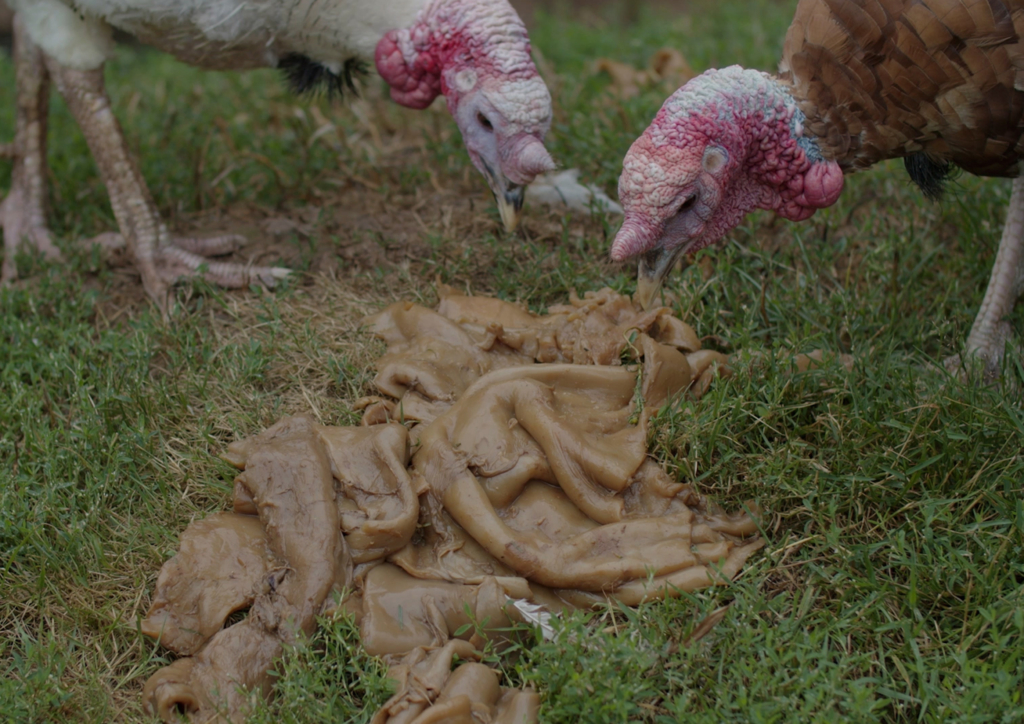
Maintenance versus Cleaning
Although written 55 years ago, Lederman Ukeles’s manifesto remains more of an appeal than a common standard for the functioning of the art field and its related institutions. ‘I felt that if the work of the whole museum focused on caring for others, society maintenance, earth maintenance – people would perceive this issue differently. I felt that the museum could become a convenient, practical institution to support this massive change’[18] – the artist wrote. These words are also worth revisiting in the context of Katarzyna Krakowiak-Bałka’s recent performative action Cleaning the Zachęta[19], to which the artist invited singers, actors and artists. The performance was intended to ‘symbolically clean the Zachęta building’ and ‘prepare it for new times’, according to the text announcing the event[20]. The staged activity completely disregarded the material dimension of cleaning, transforming it into an abstracted auditory spectacle, ‘cleaned’ of physical labour and of any context other than the artistic, institutional one. The performance conformed to the conventional perception of art as a realm associated with abstract beauty, untainted by the dirt of everyday labour. The polyphony could only be heard in the timbre of the voices, but not, for example, in the opening of the event to new groups of participants. This action should be seen in the context of the change of government in Poland and the recent dismissal of the director of Zachęta, who had been appointed by the previous political leadership. Thus, Krakowiak-Bałka’s abstract act of cleaning becomes a gesture of sanctioning a new order of power, fitting into the logic of taking over and appropriating. Maintenance art, as proposed by Lederman Ukeles, was an action aimed at building coalitions of people and entities devalued by the system, including the art system, through an emancipatory project, inclusive and genuinely democratising, advocating a change in paradigms that give superior value to some (abstract) actions and take it away from others (material, reproductive). Devoid of critical, materialist reflection, the performance Cleaning the Zachęta supports (perhaps unwittingly) the narrative of domination, reaffirming the role of art as a symbolic extension of power – here, the one that returns.
[18] See https://pressto.amu.edu.pl/index.php/prt/article/view/19353/19121 (accessed 9 April 2024).
[19] See. https://zacheta.art.pl/pl/kalendarz/katarzyna-krakowiak-balka-czyszczenie-zachety (accessed 9 April 2024).
[20] Ibid.
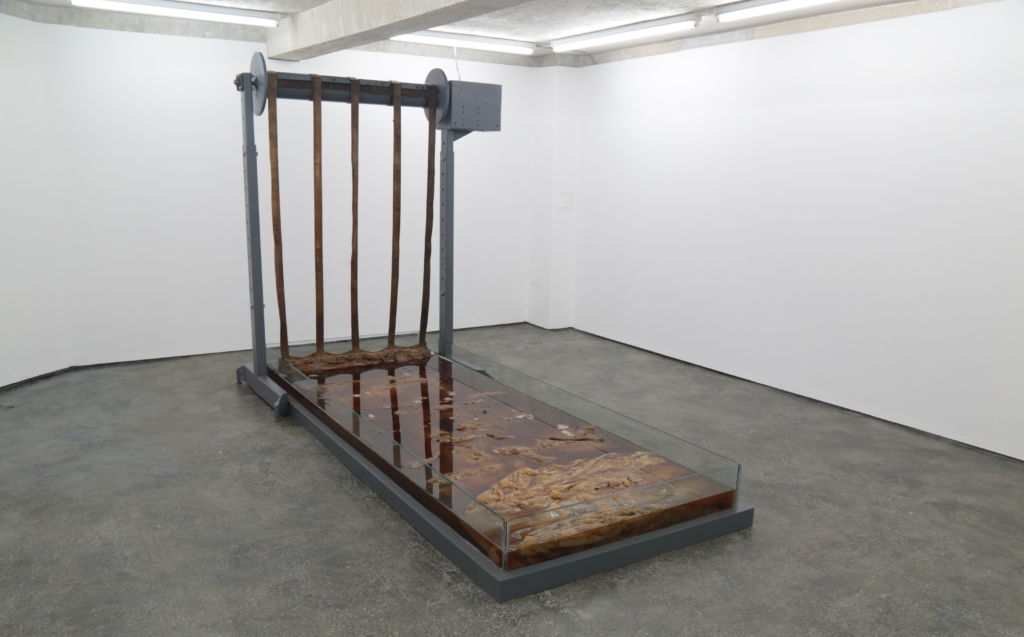
Maintenance Art Exhibition and Affinity Institution
I think it is worth revisiting the idea of a ‘maintenance art exhibition’ proposed in Mierle Laderman Ukeles’s 1969 manifesto, which would take on an allied role in processes of social change. This change would involve recognising the reproductive tasks associated with dirt, matter and repetition – far from sublime exaltations, but essential to the maintenance of a home, an institution, a city and ultimately the world. Here, art would be any activity performed for the common good, not striving for uniqueness, but being what is ‘done well’, with regard to the context in which it is produced. Ukeles’s manifesto corresponds to Donna J. Haraway’s concept of ‘response-ability’[21], which, in response to the abandonment of anthropocentric narratives and the need to confront the changes brought about by centuries of capitalist exploitation, proposes ‘staying with the trouble’[22] on a damaged earth. Response-ability is thus an egalitarian, interspecies ethic of being with the world as it is, a counter-narrative to the catastrophic and overwhelming one proposed by Timothy Morton. It also corresponds to ‘care for post-nature’ advocated by Ewa Bińczyk and referred to by Skowrońska in the curatorial text.[23] This concept involves repairing what can be reconstructed on a scale that would not hamstring all action from the very outset. Here, too, nature is not separated from what is human. It remains in process, undergoing changes that can and must still be influenced, even if the scope of this action is limited and sometimes involves withdrawing from activity.[24]
An institution that would want to base its work on the appreciation of reproductive (Lederman, Romankiv) and organisational (Perry, Krasny) labour, the theory and practice of response-ability proposed by Haraway, and the care of post-nature (Bińczyk), would have to reject the logic of dominance and exclusivity in favour of co-creating networks and alliances, including those beyond the already established field of art. The directions of this change (in addition to those mentioned above) could be set by those who are engaged in reproductive work today and throughout history: gleaners, servants, weavers, hoarders, as well as the creators of the 19th century concept of ‘cooperative housekeeping’, such as Melusina Fay Peirce, Mary Livermore and Charlotte Perkins, or, in a different context, Alexandra Kołłontaj. They could also be more contemporary creators of manifestos and more or less revolutionary care movements, such as the one initiated in Germany by Gabriele Winker, author of the ground-breaking Care Revolution. Schritte in eine solidarische Gesselschaft (2015). This post-natural and eco-socialist ethics of care could become a good counterbalance to apocalyptic, over-aestheticized hypernarratives. Especially because it is supported by the very concrete experiences of marginalised people and entities for whom resistance is daily practices.
[21] See Donna J. Haraway, When Species Meet, Minneapolis: University of Minnesota Press, 2008.
[22] See Donna J. Haraway, Staying with the Trouble. Making Kin in the Chthulucene, Durham: Duke University Press, 2026.
[23] See https://zacheta.art.pl/en/wystawy/zza-gor-sie-slonce-wznosi-blade?setlang=1 (accessed 16 April 2024).
[24] See https://etyka.uw.edu.pl/index.php/etyka/article/view/42/20 (accessed 16 April 2024).

